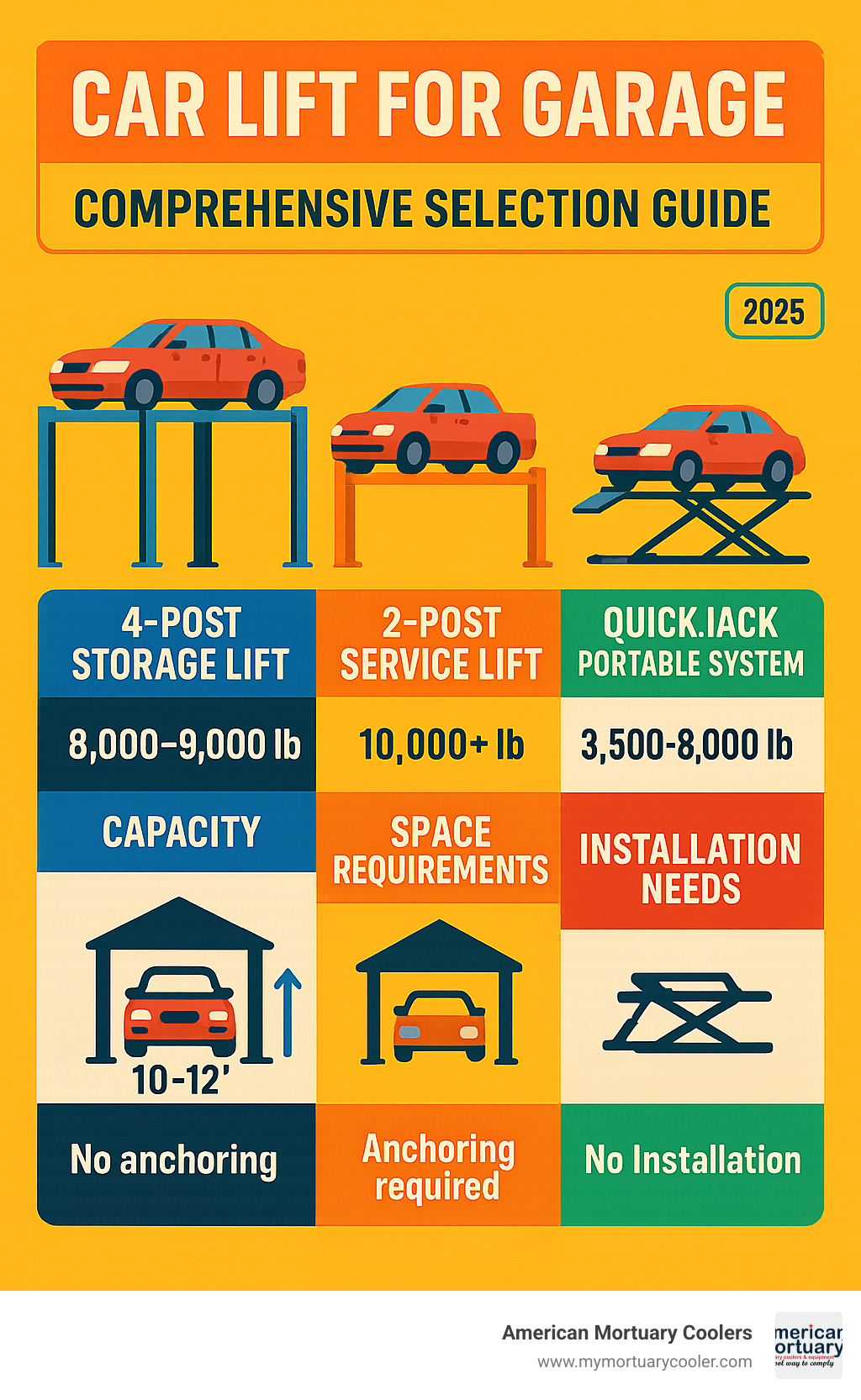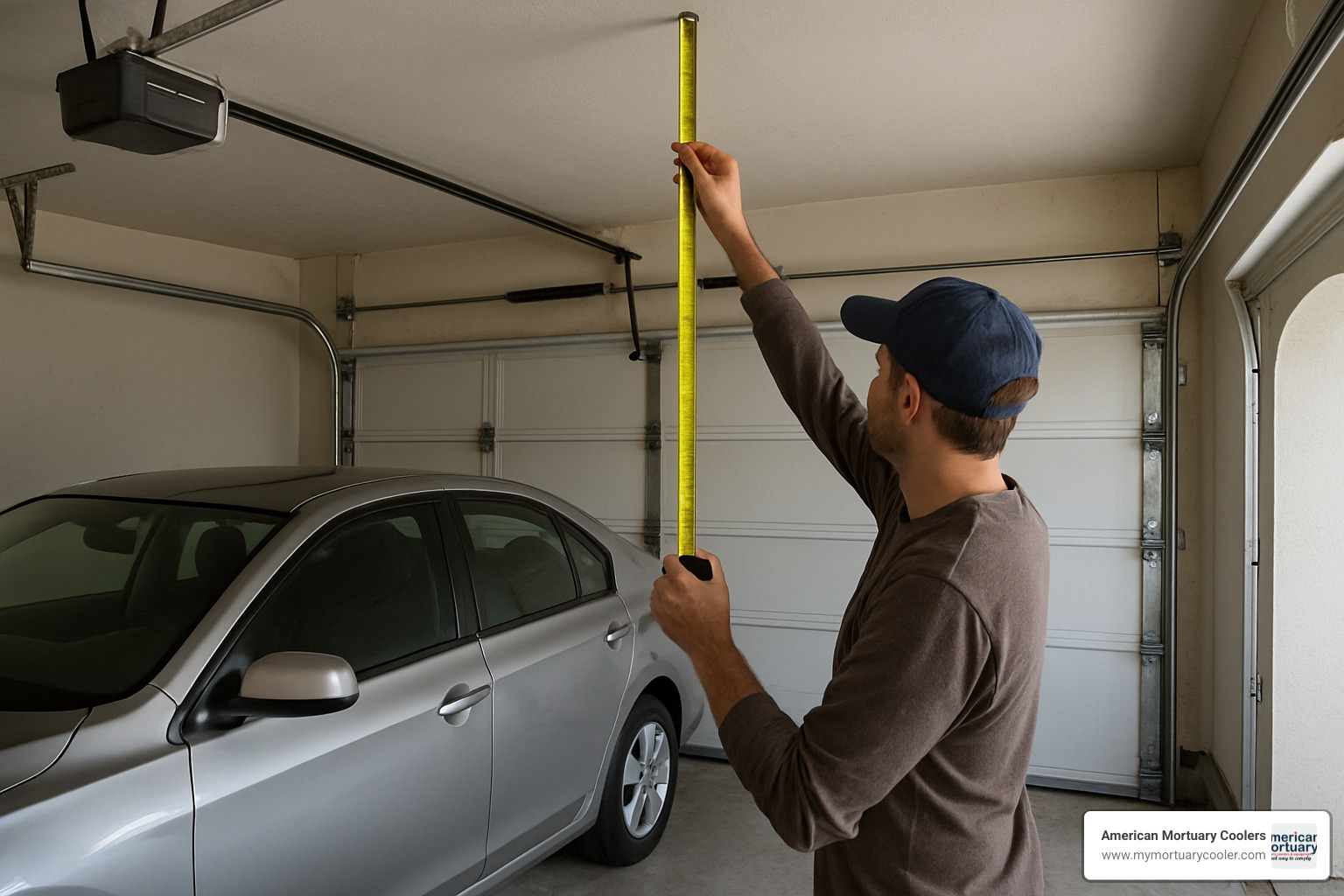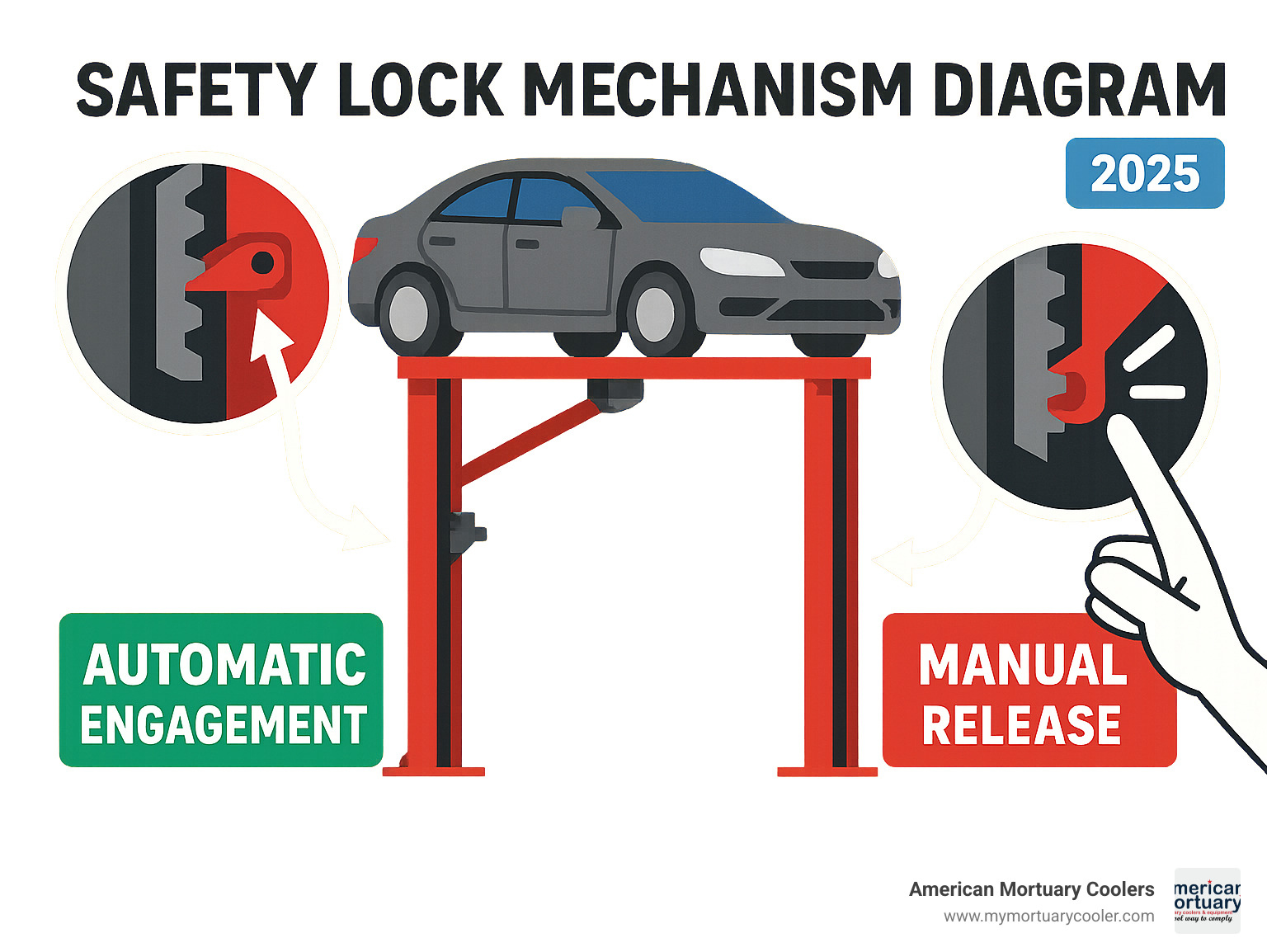Why a Car Lift for Garage Installation Can Transform Your Vehicle Storage and Maintenance
A car lift for garage use allows homeowners to double their parking space and make vehicle maintenance safer and more comfortable. Here's what you need to know:
Main Types:
- 4-Post Lifts - Best for storage, 8,000-9,000 lb capacity, no floor anchoring required
- 2-Post Lifts - Ideal for repairs, require concrete anchoring, 10,000+ lb capacity
- Portable Lifts - QuickJack style, 3,500-8,000 lb capacity, no installation needed
- Scissor Lifts - Compact design, good for low ceilings, wheel-free access
Key Requirements:
- Minimum 10-12 feet ceiling height
- 4+ inch concrete slab at 3,000 PSI (for permanent lifts)
- 110V electrical connection
- Adequate floor space for vehicle plus lift footprint
Installing a car lift transforms how you use your garage space. Instead of choosing between parking and working on vehicles, you can do both. A 4-post lift literally doubles your parking capacity by allowing you to stack two vehicles in the footprint of one.
Beyond storage, lifts make maintenance tasks like oil changes, tire rotations, and brake work much easier on your back. No more crawling under cars or struggling with floor jacks and stands.
Safety and convenience drive most purchase decisions. Modern residential lifts include automatic safety locks, redundant cable systems, and simple push-button operation.
I'm Mortuary Cooler, and while my primary expertise lies in mortuary equipment, I've helped many funeral home directors evaluate car lift for garage installations for their fleet maintenance needs. My experience with heavy-duty lifting equipment translates directly to residential garage applications.

Relevant articles related to car lift for garage:
Reader Takeaway
By the end of this guide, you'll understand how to select the right car lift for garage based on your specific needs, budget, and space constraints. We'll cover safety considerations, installation requirements, and long-term value to help you make an informed decision that transforms your garage into a more functional workspace.
Understanding Car Lifts 101
A car lift for garage is your personal automotive elevator. Most residential lifts rely on hydraulic power - a small electric motor (usually 110V) drives a hydraulic pump that pressurizes fluid through cylinders. This pressurized fluid does the heavy lifting with the push of a button.
Weight distribution is what makes lifts safe. Unlike floor jacks that concentrate weight on a single point, lifts spread the load across multiple contact points - four wheels on a 4-post lift or frame contact points on a 2-post system.
Lifting capacity varies by type. Most residential 4-post lifts handle 8,000 to 9,000 pounds, covering virtually every car, SUV, and light truck. Two-post lifts often reach 10,000+ pounds, while portable systems range from 3,500 to 8,000 pounds.
What Is a Car Lift and Why Use One?
A car lift for garage raises your vehicle safely off the ground, distributing weight across the entire frame or all four wheels. This delivers convenience and safety benefits that professional mechanics have used for decades.
Time savings become obvious quickly. Oil changes that used to require 15 minutes of positioning on jack stands become 10-minute tasks. The back-saving ergonomics eliminate neck strain and awkward positions by bringing work to a comfortable height.
Common Home-Garage Applications
Oil changes top the list - walk upright underneath with easy access to drain plugs and filters. Seasonal tire swaps become enjoyable instead of dreaded, switching all four tires with one lift instead of multiple jack points.
Restoration projects transform with lift access. Work comfortably for hours with full underneath access and roll tool carts right under the vehicle. Winter storage represents ultimate space-saving - store your classic car above your daily driver, doubling garage capacity.
Car Lift for Garage: Comparing Lift Types and Capacities
Choosing the right car lift for garage installation means understanding what each type does best. Two-post lifts are repair workhorses with complete underneath access. Four-post lifts are storage champions for stacking vehicles. Scissor lifts save space by folding flat. Portable lifts require no installation.
| Lift Type | Capacity | Ceiling Height | Floor Anchoring | Best For |
|---|---|---|---|---|
| 2-Post | 10,000+ lbs | 11-12 ft | Required | Repairs, maintenance |
| 4-Post | 8,000-9,000 lbs | 10-11 ft | Optional | Storage, parking |
| Scissor | 6,000-10,000 lbs | 9-12 ft | Required | Compact spaces |
| Portable | 3,500-8,000 lbs | 8-9 ft | None | Occasional use |
Choosing a Two-Post Car Lift for Garage
Two-post lifts come in symmetrical (equal arm lengths) and asymmetrical designs (shorter front arms). Asymmetrical lifts position doors between posts instead of into them, making access easier during work.
Frame contact points are critical for safety - every vehicle has designated lift points marked in manuals or stamped on frames. For serious work like engine swaps, two-post lifts provide unobstructed access with wheels hanging free.
Most residential units offer 10,000-lb capacity but require anchoring into 4-inch concrete rated for 3,000 PSI minimum.
Four-Post Parking & Service Lifts
Four-post lifts use runways supporting vehicles through wheel engagement. This runway design creates incredible stability and perfect double parking capability - two cars in one footprint.
Typical 8,000 to 9,000-lb capacity covers most homeowner vehicles. Caster kits let you roll unloaded lifts to different positions. Drip trays catch inevitable fluid leaks, protecting garage floors.
Scissor & Mid-Rise Lifts
Scissor lifts use compact footprints that fold completely flat when lowered. Low-ceiling applications work with just 9-10 feet versus 11-12 feet for other lifts. Mid-rise height provides comfortable working access while keeping vehicles reachable.
For detailed scissor lift guidance, check our detailed guide to choosing the best scissor car lift for your garage.
Portable Car Lift for Garage Options
Portable scissor lifts like QuickJack models slide under vehicles with just 3-3.5 inches collapsed height. Capacity reaches 8,000 lbs maximum covering most homeowner vehicles.
Easy storage using wall hangers means zero floor space when not in use. Safety comes built-in through automatic locking bars that engage as lifts rise.
For more lifting equipment insights, visit our blog where we share knowledge from professional-grade lifting systems.
Planning & Fitment: Will a Lift Fit in Your Space?

The three critical measurements for car lift for garage installation are ceiling height, floor space, and concrete thickness. Most lifts need 10-12 feet of clearance - that's the lift plus your tallest vehicle plus maximum rise.
Don't forget garage door tracks and springs that eat overhead space. Many installations require high-lift door conversion kits ($500-1,000) to move tracks higher on walls.
Concrete slabs need at least 4 inches thick at 3,000 PSI minimum for permanent lifts. Check for cracks or deterioration before drilling anchor holes.
Measuring Floor Space & Door Clearance
Runway length on 4-post lifts handles vehicles up to 16-18 feet long. Post width requires about 12 feet between posts, but posts add 2-3 feet on each side - meaning 16-18 feet total garage width for comfortable installation.
When 2-post lifts raise vehicles, arms extend beyond car outlines. If door tracks interfere, you'll need high-lift conversions or lift repositioning.
Assessing Electrical & Structural Requirements
Most residential lifts run on standard 110V power, though larger units may require 220V connections. Recommend 30-amp breakers for lifts with 1 HP motors to prevent nuisance tripping.
Invest in a rebar scanner ($50-100) before drilling anchor holes. Hitting rebar ruins equipment and creates unsafe anchor installations. 3/4-inch wedge anchors are standard - follow manufacturer specs exactly for safe operation.
Safety, Installation & Maintenance Essentials

ALI certification is non-negotiable when shopping for lifts - it means rigorous safety testing. ETL certification covers electrical components. Modern lifts include automatic safety locks that engage every few inches and cable slack detection systems for redundant protection.
Daily visual inspections should check for fluid leaks, unusual noises, or wear signs. Annual professional service ensures safety systems work properly and catches problems early.
DIY vs Professional Installation
Many homeowners can install residential lifts using bolt-up kits with detailed instructions, saving $500-1,500 in labor. However, certified technicians handle unexpected issues and carry insurance.
Torque specifications are critical - under-torqued bolts loosen over time, over-torqued bolts strip threads. Shim leveling compensates for sloped garage floors, where professionals earn their money.
Routine Care to Extend Lift Life
Lubrication points need monthly attention. Cable tension checks should show equal tension with no fraying or corrosion. Rust prevention through regular cleaning and touch-up painting prevents major repairs.
Annual load testing by qualified technicians ensures continued safe operation - think of it as an annual physical for your lift.
Cost, Brands & How to Pick the Right Car Lift for Garage
Car lift for garage prices range from $1,500 for basic 4-post lifts to $6,000+ for premium 2-post systems. Add $500-2,000 for installation labor and $500-1,500 for accessories like drip trays and caster kits.
Quality brands like BendPak offer impressive warranties - 5-2-1 coverage (5 years structure, 2 years hydraulics, 1 year electrical). Financing through manufacturers or retailers makes premium lifts more accessible with 6-12 month payment plans.
Budget vs Premium: Total Cost of Ownership
A $1,500 budget lift needing repairs every two years isn't cheaper than a $3,500 premium lift running trouble-free for decades. Safety features justify premium pricing - better locks, redundant cables, and quality hydraulics prevent accidents.
Downtime costs add up with budget equipment. Failed lifts create inconvenience, trap vehicles, or require expensive emergency service. Premium lifts have better reliability and faster warranty response.
Shortlist & Decision Checklist
Vehicle weight determines minimum capacity needed. Garage dimensions eliminate options immediately. Primary use case drives the decision between storage-focused 4-post lifts versus repair-oriented 2-post systems.
Future needs deserve consideration - larger vehicles, different garages, or expanding automotive hobbies. Choose lifts that can grow with changing requirements.
For hydraulic lift guidance, see our guide on scissor lift secrets: choosing the perfect hydraulic lift.
Frequently Asked Questions About Car Lift for Garage
How thick should my concrete slab be?
Your concrete needs at least 4 inches thick with minimum 3,000 PSI strength for most residential lifts. This applies to both 2-post lifts requiring anchoring and 4-post systems. The concrete should be in good condition without significant cracks, crumbling edges, or flaking surfaces.
Some heavier lifts require 6-inch concrete, but most homeowners won't need this. When in doubt, have a concrete contractor inspect - it's cheaper than finding problems after purchase.
Do I need to anchor a 4-post lift?
Anchoring is optional for 4-post lifts. The lift's weight and wide footprint provide stability for typical homeowner use, making installation simpler and less permanent.
However, anchoring becomes recommended for heavy use - multiple daily cycles or serious repair work where you'll apply significant force. Without anchoring, lifts can gradually shift position during repeated use.
Most manufacturers include anchor hardware, so you can start without anchoring and add it later if needed.
What maintenance is required annually?
Annual professional inspection should check hydraulic fluid, test safety systems, inspect cables, and perform load testing. Hydraulic fluid typically needs annual attention - clean fluid prevents pump damage.
Cable inspection is critical since they're literally holding your vehicle. Look for fraying, kinking, rust, or uneven wear. Replace at first sign of problems.
Monthly maintenance includes visual checks, cleaning moving parts, and testing safety locks. Keep a simple maintenance log for warranty compliance and problem tracking.
Conclusion
Installing a car lift for garage use represents one of the smartest investments you can make in your home workspace. Whether you've decided on a 4-post lift to double your parking space, a 2-post lift for serious repair work, or a portable system for occasional maintenance, you're about to transform how you use your garage.
The benefits extend far beyond the initial excitement of installation. Space maximization becomes immediately apparent when you can park two vehicles where one used to fit, or when you can comfortably work underneath your car without crawling on cold concrete. Your back will thank you after the first oil change at standing height instead of lying on a creeper.
At American Mortuary Coolers, we understand the importance of quality lifting equipment. While our primary expertise involves mortuary coolers and funeral industry equipment, we've seen how reliable lifting systems impact daily operations across our Tennessee headquarters and nationwide delivery network. The same principles that make our mortuary equipment dependable - safety first, quality construction, and thoughtful design - apply to any lifting equipment purchase.
Measure twice and lift once isn't just a catchy phrase - it's essential advice that prevents expensive mistakes. Those ceiling height measurements, concrete thickness checks, and electrical assessments we discussed aren't optional steps. They're the foundation of a successful installation that serves you safely for decades.
Don't let price be your only deciding factor. A quality lift from a reputable manufacturer with proper safety certifications costs more upfront but delivers better value through reduced maintenance, improved safety, and higher resale value. The peace of mind that comes with automatic safety locks, redundant systems, and solid warranties is worth the investment.
Your garage is about to become a much more functional space. Whether you're storing a classic car above your daily driver, performing routine maintenance in comfort, or tackling that restoration project you've been putting off, the right lift makes it all possible.
For more insights about lifting solutions and equipment selection, visit our blog section where we share knowledge from our experience with heavy-duty, reliable lifting systems across various applications.



















